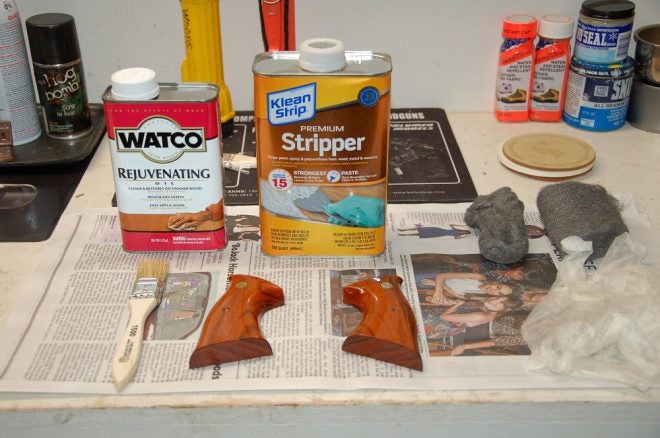Refinishing Handgun Grips
Dr. John Woods 01.10.17

Gun shows are a great venue for perusing the tables for goodies, rarities, and deals. Well, not so much the deals anymore, because bickering back and forth with a gun dealer has virtually become a lost art. But, just occasionally you run into something special.
That was the case recently when inspecting a table of vintage Smith and Wesson’s I found something to fit my collection. It was a mint Smith Model 57 (no hyphened frame number), .41 magnum, 6-inch barrel, blued, pinned barrel, and recessed cylinder. There was no box or original papers so the dealer had it priced at $1225. That was a little rich for my blood.
At least a half dozen times I visited that table and worked on the dealer. With the show closing at 5PM, I was standing as his table again at 4:30. He finally gave in to my deal. That was not the end. He had another N-Frame Smith with smooth factory Goncalo Alves wood grips. I have several N-Frames with the zebrawood/tigerwood. New, they retail for around $150 if you can find them with the metal S&W medallion insert.
The handgun I bought had the standard checkered magna grips. Ironically, the dealer had no fond attraction to the Goncalo Alves, so he was willing to swap them out, even. Done deal.
These grips had the usual glossy, thick lacquer finish. I preferred a smooth, matte, oiled wood, so as I have done before, I refinished them.
The process is not rocket science. Remove the grips via the grip screw. Examine them. Buy a can of furniture finish stripper, a small paint brush, and some fine steel wool. Have a clean, dry cotton rag, an old toothbrush, and protective gloves.
Read the directions on the stripper chemical, then paint a heavy coat of it on each grip front side. Allow the chemical to work for 15 minutes. Then use the cotton cloth to wipe each panel down, removing all the old finish. Repeat as necessary. Then do the back sides. Use the toothbrush to get into all the edges. Rub down each panel with fine steel wool. Allow them to dry overnight.
Examine to be sure all the old lacquer was removed. Polish again if necessary. Apply a hand-rubbed coat of a good wood oil. Let that dry. Repeat again if desired. Re-install and let that wood grain show off.